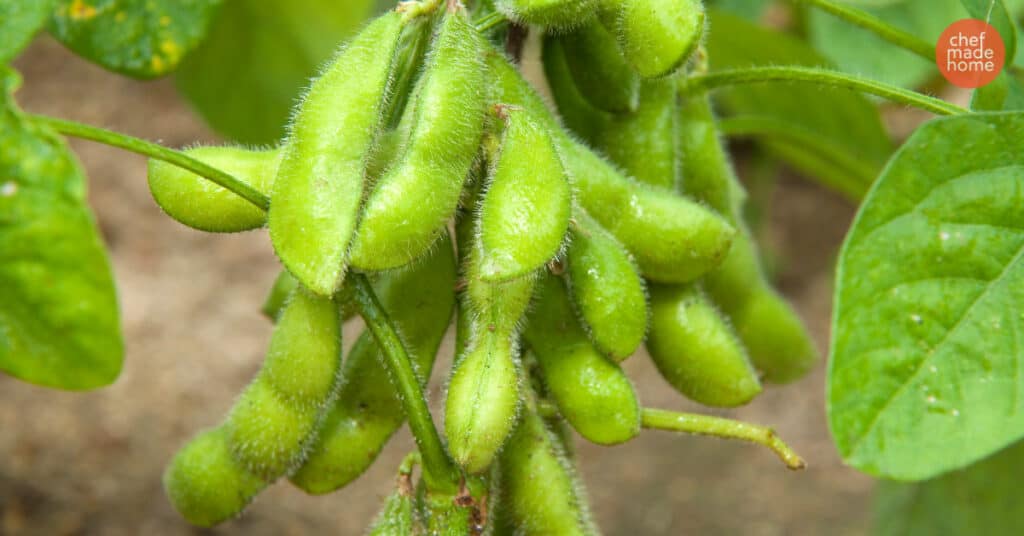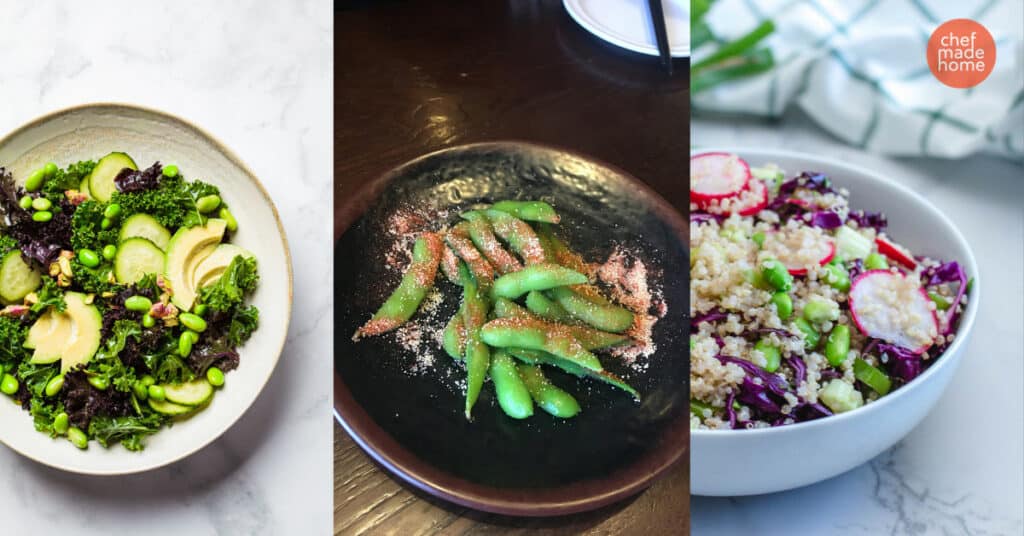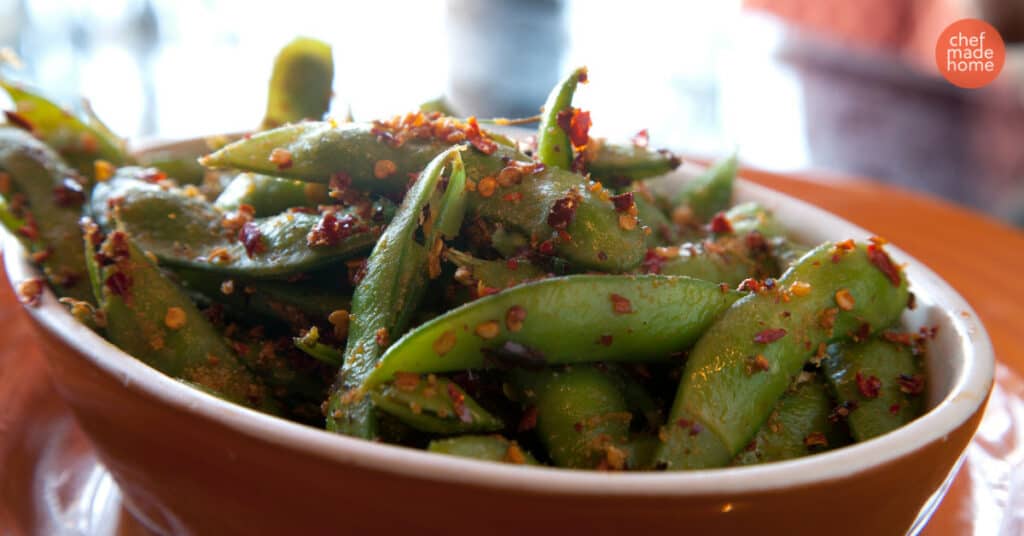**SUMMARY:** Mukimame and edamame are both immature soybeans harvested before they reach maturity. While mukimame is a generic term that refers to immature soybeans, edamame specifically refers to immature soybeans that are boiled or steamed and served as a snack or vegetable dish.
Do you need clarification about the difference between mukimame and edamame?
Have no fear, as we are here to shed light on these soybean varieties and help you navigate the battle of the soybeans!
In this article, we will explore the following:
- The origins and characteristics of mukimame
- The culinary versatility and health benefits of edamame
- A face-off comparing mukimame and edamame in terms of taste, texture, and cultural significance
- Exciting recipes and innovative ways to incorporate these soybean wonders into your meals
So, get ready to delve into the intriguing world of mukimame and edamame as we unravel their distinct qualities and unlock their culinary possibilities!
Mukimame: From Humble Bean To Culinary Delight

Mukimame, a lesser-known soybean variety, has been making waves in the culinary world with its unique flavor and nutritional profile. Originating in Japan, this vibrant green legume has rapidly gained popularity across different cuisines. Let’s dive into the world of mukimame and discover its fascinating journey.
Defining Mukimame
Mukimame, also known as “peeled soybeans,” refers to soybeans harvested young and still in their pods. The name “mukimame” comes from the combination of two Japanese words: “muku,” meaning “peeled,” and “mame,” meaning “beans.” These soybeans are harvested before reaching full maturity when they are still tender and have a vibrant green color.
A Brief History
Mukimame is deeply rooted in Japanese culinary traditions, where it has been enjoyed for centuries. These tender soybeans were initially cultivated for their nutritional benefits and ability to enrich various dishes. Over time, mukimame gained recognition beyond Japan’s borders and found its way into diverse international cuisines.
Nutritional Powerhouse
Mukimame is not only delicious but also packs a nutritional punch. These young soybeans are a valuable plant-based protein, fiber, vitamins, and minerals source. They are particularly rich in folate, iron, calcium, and vitamin K. Incorporating mukimame into your diet can contribute to overall health and well-being.
Culinary Uses And Preparation
Mukimame’s versatility in the kitchen is truly remarkable. These tender soybeans can be boiled, steamed, or sautéed to create delightful dishes that tantalize the taste buds. They can be enjoyed as a snack, tossed into salads for a burst of flavor, or incorporated into stir-fries, soups, and stews. The possibilities are endless when it comes to mukimame.
Stay tuned as we now turn our attention to edamame, another soybean superstar that has captured the hearts of many with its remarkable taste and presence in East Asian cuisines.
Mukimame Vs Edamame – What Sets Them Apart?
Several factors set these soybean varieties apart when it comes to mukimame and edamame. From taste and texture to appearance and cultural significance, understanding the differences can significantly enhance your culinary experience. Let’s dive into the comparative analysis of mukimame vs edamame to shed light on their unique characteristics.
Taste
- Mukimame: Known for its delicate and subtly sweet flavor with a slightly nutty undertone.
- Edamame: Renowned for its mild buttery taste, it is often described as slightly sweet with a hint of saltiness.
Texture
- Mukimame: Tender and creamy texture that melts in your mouth.
- Edamame: Firm and chewy texture that provides a satisfying bite.
Appearance
- Mukimame: Larger in size, mukimame beans feature a bright green color and plump shape.
- Edamame: Comparatively more petite in size, edamame beans are vibrant green and have a more compact shape.
Culinary Experience
- Mukimame: Due to its subtle flavor, mukimame is often used as an ingredient in various dishes, including salads, stir-fries, soups, and sushi.
- Edamame: Traditionally served as a snack or appetizer, edamame is commonly enjoyed lightly salted or seasoned. It can also be incorporated into fried rice, stews, and noodle dishes.
Cultural Significance
- Mukimame: Mukimame is commonly found in Middle Eastern and Mediterranean cuisines, where it has been a part of the culinary traditions for centuries.
- Edamame: Originating in East Asia, particularly in Japan and China, edamame is a staple in these cultures and is often associated with traditional Japanese cuisine.
Preferred Usage
- Mukimame: Due to its creamy texture and mild flavor, mukimame is often used as a versatile ingredient that can be easily incorporated into various recipes.
- Edamame: With its firm texture and distinct taste, edamame is frequently enjoyed as a standalone snack or a side dish in many Asian cuisines.
These differences in taste, texture, appearance, and culinary usage make both mukimame and edamame unique in their own ways. Whether you are exploring new recipes or seeking to add nutritional value to your meals, understanding the distinct qualities of these soybean varieties can make a significant difference in your culinary adventures. Let’s now move on to the next section and delve into the fascinating world of mukimame and edamame recipes and innovative ways to incorporate them into your everyday meals.

Exploring Recipes And Innovations
Innovative Recipes Featuring Mukimame And Edamame
Here are some innovative recipes to inspire you to experiment with both mukimame and edamame:
- Mukimame Hummus
- Blend cooked mukimame with tahini, garlic, lemon juice, olive oil, and seasonings.
- For a nutritious and flavorful dip, serve with pita bread, crackers, or fresh vegetables.
- Edamame Guacamole
- Use steamed and shelled edamame as a substitute for avocado in a classic guacamole recipe.
- Mix with lime juice, chopped tomatoes, onions, cilantro, and spices for a unique twist on a beloved dip.
- Mukimame Quinoa Salad
- Combine cooked and cooled mukimame with cooked quinoa, diced vegetables, and a tangy vinaigrette dressing.
- Enjoy this refreshing salad as a light, protein-packed meal or a side dish.
- Edamame Stir-Fry
- Sauté edamame pods with your favorite vegetables, such as bell peppers, carrots, and snow peas.
- Add soy sauce, ginger, and garlic for a flavorful and nutritious stir-fry served over rice or noodles.
Culinary Versatility And Adaptability
Both mukimame and edamame can be used in various cuisines and dishes. Here are some tips and recommendations for incorporating them into your everyday meals:
- Salads: Add mukimame or edamame to green salads for an extra protein boost and a vibrant pop of color.
- Stir-Fries: Toss mukimame or edamame into stir-fry dishes to add texture and nutritional value.
- Soups: Enhance the flavor and heartiness of soups by adding mukimame or edamame towards the end of cooking.
- Pasta Dishes: Mix cooked and shelled edamame into pasta salads or toss with pasta for added protein.
- Snacks: Enjoy edamame as a nutritious and satisfying snack. Simply boil or steam the pods and sprinkle with salt or your favorite seasonings.
Remember, mukimame and edamame can be easily incorporated into your preferred cuisines and recipes, allowing you to discover new flavors and textures.

Key Takeaways
This blog post delves into the fascinating world of mukimame and edamame, exploring their unique characteristics, culinary uses, and cultural significance. Here is a summary of the key takeaways:
- Mukimame and edamame are soybean varieties with distinct taste, texture, and appearance.
- Mukimame is known for its delicate flavor, creamy texture, and larger size. At the same time, edamame has a mild and buttery taste with a firmer texture.
- Mukimame is commonly used as an ingredient in various dishes. At the same time, edamame is often enjoyed as a standalone snack or side dish.
- Mukimame has cultural significance in Middle Eastern and Mediterranean cuisines. At the same time, edamame is a staple in East Asian cuisine, particularly in Japan and China.
- Both mukimame and edamame are versatile and adaptable, allowing for various culinary possibilities.
By understanding the differences between mukimame and edamame, you can enhance your culinary experiences and explore innovative recipes.
So, whether you want to add a nutritious punch to your salads or create unique dips and spreads, mukimame and edamame can provide endless possibilities.
Now that you are well-informed about mukimame and edamame, it’s time to embark on your culinary adventure and enjoy the benefits of these soybean wonders. Start experimenting with recipes, and let your taste buds be your guide.
Whether you choose mukimame or edamame, you can’t go wrong with these nutrient-rich, versatile, and delicious soybean varieties.
Frequently Asked Questions (FAQ)
Here are answers to some common questions about mukimame and edamame:
Are mukimame and edamame the same soybean variety?
No, mukimame and edamame are different varieties of soybeans. Mukimame is harvested when the beans are fully matured. In contrast, edamame is harvested when the beans are still young and tender.
Can I substitute mukimame for edamame in recipes (or vice versa)?
While mukimame and edamame can be used interchangeably in some recipes, it’s essential to consider the differences in flavor and texture. Mukimame’s creaminess and mild sweetness may work well in dips and spreads. At the same time, edamame’s firmer texture is often preferred in salads or stir-fries.
Are mukimame and edamame suitable for vegetarians and vegans?
Mukimame and edamame are excellent plant-based protein sources, making them ideal for vegetarian and vegan diets.
How can I cook mukimame and edamame?
Mukimame and edamame can be boiled, steamed, or microwaved until tender. They are typically enjoyed lightly salted or seasoned to taste.

